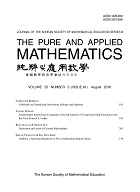 ISSN : 1226-0657
ISSN : 1226-0657
권호 목록
- 2024 (31권)
- 2023 (30권)
- 2022 (29권)
- 2021 (28권)
- 2020 (27권)
- 2019 (26권)
- 2018 (25권)
- 2017 (24권)
- 2016 (23권)
- 2015 (22권)
- 2014 (21권)
- 2013 (20권)
- 2012 (19권)
- 2011 (18권)
- 2010 (17권)
- 2009 (16권)
- 2008 (15권)
- 2007 (14권)
- 2006 (13권)
- 2005 (12권)
- 2004 (11권)
- 2003 (10권)
- 2002 (9권)
- 2001 (8권)
- 2000 (7권)
- 1999 (6권)
- 1998 (5권)
- 1997 (4권)
- 1996 (3권)
- 1995 (2권)
- 1994 (1권)
21권 4호
초록
Abstract
In this paper, we study two types of 1-lightlike submanifolds, named by lightlike hypersurface and half lightlike submanifold, of an indefinite Sasakian manifold admitting non-metric <TEX>${\theta}$</TEX>-connections. We prove that there exist no such two types of 1-lightlike submanifolds of an indefinite Sasakian manifold.
초록
Abstract
Let M be a prime <TEX>${\Gamma}$</TEX>-ring and let d be a derivation of M. If there exists a fixed integer n such that <TEX>$(d(x){\alpha})^nd(x)=0$</TEX> for all <TEX>$x{\in}M$</TEX> and <TEX>${\alpha}{\in}{\Gamma}$</TEX>, then we prove that d(x) = 0 for all <TEX>$x{\in}M$</TEX>. This result can be extended to semiprime <TEX>${\Gamma}$</TEX>-rings.
초록
Abstract
In this paper, we investigate the relationships between fuzzy relations and Alexandrov L-topologies in complete residuated lattices. Moreover, we give their examples.
초록
Abstract
In this article, we consider a homogeneous function of degree four in quaternionic vector spaces and <TEX>$S^{4n+3}$</TEX> which is invariant under <TEX>$S^3$</TEX> and U(n + 1)-action. We show it is an isoparametric function providing isoparametric hypersurfaces in <TEX>$S^{4n+3}$</TEX> with g = 4 distinct principal curvatures and isoparametric hypersurfaces in quaternionic projective spaces with g = 5. This extends study of Nomizu on isoparametric function on complex vector spaces and complex projective spaces.
초록
Abstract
Let <TEX>$T_l$</TEX> be a transformation on the interval [-1, 1] defined by Chebyshev polynomial of degree <TEX>$l(l{\geq}2)$</TEX>, i.e., <TEX>$T_l(cos{\theta})=cos(l{\theta})$</TEX>. In this paper, we consider <TEX>$T_l$</TEX> as a measure preserving transformation on [-1, 1] with an invariant measure <TEX>$\frac{1}{\sqrt[\pi]{1-x^2}}dx$</TEX>. We show that If f(x) is a nonconstant step function with finite k-discontinuity points with k < l-1, then it satisfies the Central Limit Theorem. We also give an explicit method how to check whether it satisfies the Central Limit Theorem or not in the cases of general step functions with finite discontinuity points.
초록
Abstract
We investigate long-term motions of the cable when cable has different types of periodic forcing term. Various different types of solutions are presented by using the 2nd order Runge-Kutta method under various initial conditions. There appeared to be small- and large-amplitude solutions which have different nodal structure.
초록
Abstract
Yan & Hanson [8] and Makate & Sattayatham [6] extended Bates' model to the stochastic volatility model with jumps in both the stock price and the variance processes. As the solution processes of finding the characteristic function, they sought such a function f satisfying <TEX>$$f({\ell},{\nu},t;k,T)=exp\;(g({\tau})+{\nu}h({\tau})+ix{\ell})$$</TEX>. We add the term of order <TEX>${\nu}^{1/2}$</TEX> to the exponent in the above equation and seek the explicit solution of f.
초록
Abstract
We prove the existence of the risk-efficient options proposed by Xu [7]. The proof is given by both indirect and direct ways. Schied [6] showed the existence of the optimal solution of equation (2.1). The one is to use the Schied's result. The other one is to find the sequences converging to the risk-efficient option.
